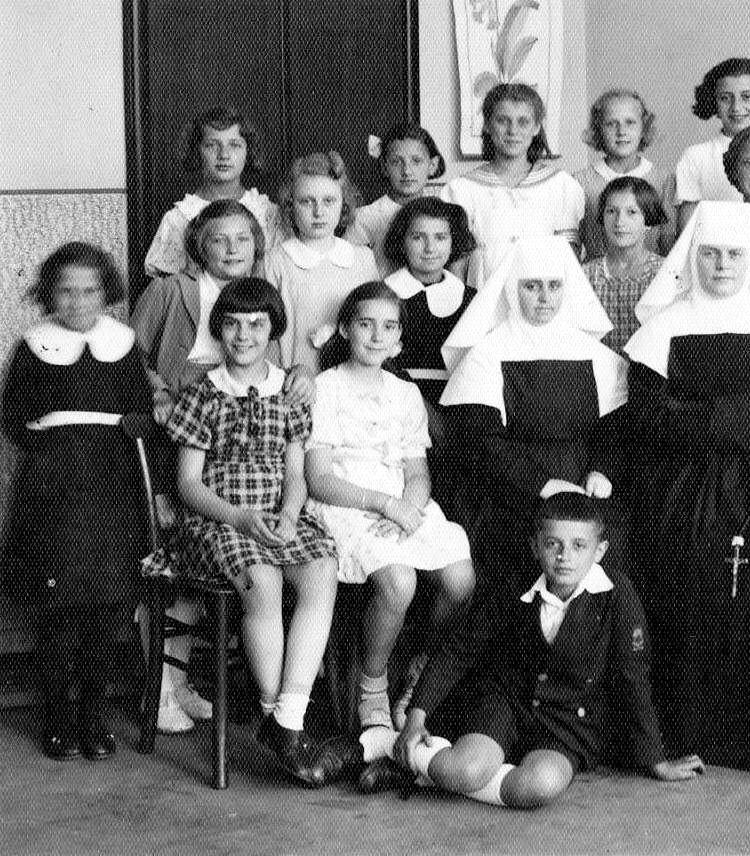
Types of Schools: Religious Association--Country Trends

Figure 1.--Religious groups still played an impotant role in European education before World War II. Here we see a scene at a Catholic school somewhere in the Balkans in the 1930s just before World War II. We think the nuns are Catholic, but actually are unsure how to differentiate between Catholic and Orthodox nuns. This apparantly was not a class because there are only two boys. (A class you have either had no boys or comparable numbers of boys and girls.) The girls mostly wear cheery stylish dresses, except for two girls who were a kind of school uniform or smock outfit complete with formal long stockings. Click on the image to see the incription on the back. Hopefully someone will translate it for us.
|
|
School religious trends varied greatly from contry to country with some regional trendsin addition to changes over time.
Africa is split between a Muslim north and a Christian south. This significantly impacts school trends. There is a strong Islamic influence in the north although there is a conflict between fundamentalists and secularists. This includes the schools. In the south there is a growing tradition of secular education.
Latin America is predominately Catholic. During the colonial era there were few schools all of which were operated by the Church. After the Wars for Libertion, liberal political parties generally suceeded in establishing secular public schools, although large numbers of children did not attend school or only received
a few years of education. Gradully systems were exoanded, although quality is still a problem. Private schools are mostly Catholic.
North America is diminated by secular public schools. The Constitution as interpreted by the Courts bans state support for religious schools. Many private schools have religious orientation. When Catholics began emigrating to America in large numbrs, Catholic leader were concerned with the Prostestant orientation of the public schools. As a result, they founded their own parochial school system. Catholic parochial schools today are having financial difficulties in part because their are fewer nuns filling teching positions. In recent years Protestant private schools have grown in importance. Canada has secular public schools. The Catholic Church plays an educational role in Quebec
Asia is a huge continent. Secular public schools are an artifact of Europen contact. China had a long tradition of schools for the elite, but they did not address many modern subjecs like science. China and the other Asian Communist countries after World War II launched atheist campaigns and the schools were completely secularized. Elsewhere in Asia, public schools are a relatively new phenomenon. Secular schools were an idea implanted by colonial powers. European religious groups founded some of the first schools in Aia. Colonial authoities were unwilling to make a major investment in public education, although the Japanese in Korea and Taiwan did. The British and French were unwilling to make the investment needed. Since de-Colonization, the new goverments have launched mass, largely secular public education, although the quality of the schools varied. They were mostly secular schools, largely due to the socialist orietation of the new leadership.
European schools have changed over time as regards to religion. With the de-Christinzation of Europe, the role of religion in euction is declining. The growing Mulim population has begin to demand a role in education which is being resisted by secular authorities. The Soviets pursued an atheist campaign, first in the Soviet Union itself, than in its Easter European empire. Preventing access to children was a priority and any form of relgious instruction was a priority. Only in Poland was there effective popular resistance. Catholic schools were not permitted or religious instructions in the state schools. The people, however, clung on to their religion as President Obama would phrase it. The Communists assumed that young people would turn to Communism becaise of the prpaganda in the schools and youth organizatuins. They did not.
Oceania had no schools before the arrival of the Europeans. Religious groups set up the first schools as part of a missionary effort. The British established schools in Australia and New Zealand. They were similar to schools in England, many of which had religions connections because of the esblished church. A secular public school system also developed. These were schools for settlers. The only public school system for the indigenous inhabitants was established by the Americans in the Philippines. After World War II, secular public schools were opened throughout Oceania.
HBC-SU

Related Chronolgy Pages in the Boys' Historical Web Site
[Main Chronology Page]
[The 1900s]
[The 1910s]
[The 1920s]
[The 1930s]
[The 1940s]
[The 1950s]
[The 1960s]
[The 1970s]
[The 1980s]
[The 1990s]
[The 2000s]
Navigate the Relate Boys Historical Clothing Uniform Garment Pages
[Main school garment page]
[Blazers]
[Bookbag]
[Caps]
[Coats]
[Hosiery]
[Kilts]
[Pants]
[Shirts]
[Shoes]
[Smocks
[Suits]
[Seaters]
[Ties]
Navigate the Boys' Historical Clothing School Uniform Country Pages
[Return to the Main School type religious page]
[Return to the Main School type page]
[Return to the Main School page]
[Return to the Main National School page]
[Australia]
[England]
[France]
[Germany]
[Ireland]
[Italy]
[Japan] [New Zealand]
[Poland]
[Singapore]
[Scotland]
[Singapore]
[United States]
Navigate the HBC School Section:
[About Us]
[Activities]
[Chronology]
[Clothing styles]
[Countries]
[Debate]
[Economics]
[Garment]
[Gender]
[Hair]
[History]
[Home trends]
[Literary characters]
[School types]
[Significance]
[Transport and travel
[Uniform regulations]
[Year level]
[Other topics]
[Images]
[Links]
[Registration]
[Tools]
[Return to the Historic Boys' School Home]
Created: 12:33 AM 9/4/2017
Last updated: 12:33 AM 9/4/2017




